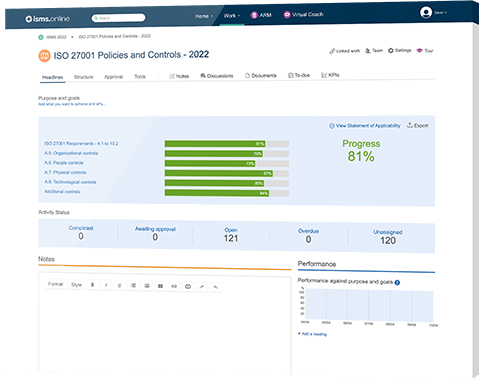
An ‘information processing facility’ (IPF) is a broad term used to describe any piece of ICT infrastructure that’s involved in processing data, such as IT equipment, software and physical facilities and locations.
IPFs play a key role in maintaining business continuity and ensuring the smooth operation of an organisation’s ICT network(s). To increase resilience, organisations need to implement measures that increase the redundancy of their IPFs – i.e. fail safe methodologies and processes that mitigate risk to systems and data in the event of failure, misuse or intrusion.
Control 8.14 is a preventive control that maintains risk by implementing plans and procedures that maintain the continuous operations of information processing facilities, and by proxy, an organisation’s entire ICT network.
| Control Type | Information Security Properties | Cybersecurity Concepts | Operational Capabilities | Security Domains |
|---|---|---|---|---|
| #Preventive | #Availability | #Protect | #Continuity #Asset Management | #Protection #Resilience |
Control 8.14 addresses an organisation’s ability to carry on doing business in the event of critical or minor failures that have the potential to impact resiliency. As such, ownership of 8.14 should reside with the Chief Operating Officer, or organisational equivalent.
The overriding goal of Control 8.14 is to increase the availability of what ISO deems to be business services and information systems, which can be interpreted as any aspect of a network that allows the organisation to conduct business.
Control 8.14 advocates for duplication as the primary methods of achieving redundancy across its various IPFs, primarily through maintaining an inventory of spare parts, duplicate components (hardware and software) and additional peripheral devices.
A redundant system is only as good as its alerting facility. As such, organisations should ensure that failed IPFs are detected quickly, and remedial action is taken to either fail over to standby hardware, or to repair the malfunctioning IPF in as quick a time as possible.
When designing and installing redundancy measures, organisations should consider the following:
Control 8.14 acknowledges the inherent link between robust, redundant systems and business continuity planning (see Control 5.30), and asks organisations to consider both as part of the solution to the same set of challenges.
It’s important to note that where business applications are concerned, it is extremely difficult to cater for critical errors in the application itself (particularly in the case of managed applications).
ISO 27002:2022-8.14 replaces ISO 27002:2003-17.2.1 (Availability of information processing facilities).
27002:2022-8.14 is an enormous operational leap from 27002:2003-17.2.1, with the difference between the two controls representing the largest change throughout the entire ISO 27002:2022 update.
27002:2003-17.2.1 contains just a few cursory paragraphs on the need to achieve redundancy, whereas 27002:2022-8.14 contains extensive guidance on precisely how to achieve this across on-premise, cloud-based, logical and physical components.
At ISMS.online, we’ve built a comprehensive and easy to use system that can help you to implement ISO 27002 controls and manage your entire ISMS.
ISMS.online makes implementing ISO 27002 easier by providing a set of tools to help you manage information security in your organisation. It will help you identify risks and develop controls to mitigate those risks, and then show you how to implement them within the organisation.
Contact us today to schedule a demo.

We’ll give you an 81% headstart
from the moment you log in
Book your demo
| ISO/IEC 27002:2022 Control Identifier | ISO/IEC 27002:2013 Control Identifier | Control Name |
|---|---|---|
| 5.7 | New | Threat intelligence |
| 5.23 | New | Information security for use of cloud services |
| 5.30 | New | ICT readiness for business continuity |
| 7.4 | New | Physical security monitoring |
| 8.9 | New | Configuration management |
| 8.10 | New | Information deletion |
| 8.11 | New | Data masking |
| 8.12 | New | Data leakage prevention |
| 8.16 | New | Monitoring activities |
| 8.23 | New | Web filtering |
| 8.28 | New | Secure coding |
| ISO/IEC 27002:2022 Control Identifier | ISO/IEC 27002:2013 Control Identifier | Control Name |
|---|---|---|
| 6.1 | 07.1.1 | Screening |
| 6.2 | 07.1.2 | Terms and conditions of employment |
| 6.3 | 07.2.2 | Information security awareness, education and training |
| 6.4 | 07.2.3 | Disciplinary process |
| 6.5 | 07.3.1 | Responsibilities after termination or change of employment |
| 6.6 | 13.2.4 | Confidentiality or non-disclosure agreements |
| 6.7 | 06.2.2 | Remote working |
| 6.8 | 16.1.2, 16.1.3 | Information security event reporting |
| ISO/IEC 27002:2022 Control Identifier | ISO/IEC 27002:2013 Control Identifier | Control Name |
|---|---|---|
| 7.1 | 11.1.1 | Physical security perimeters |
| 7.2 | 11.1.2, 11.1.6 | Physical entry |
| 7.3 | 11.1.3 | Securing offices, rooms and facilities |
| 7.4 | New | Physical security monitoring |
| 7.5 | 11.1.4 | Protecting against physical and environmental threats |
| 7.6 | 11.1.5 | Working in secure areas |
| 7.7 | 11.2.9 | Clear desk and clear screen |
| 7.8 | 11.2.1 | Equipment siting and protection |
| 7.9 | 11.2.6 | Security of assets off-premises |
| 7.10 | 08.3.1, 08.3.2, 08.3.3, 11.2.5 | Storage media |
| 7.11 | 11.2.2 | Supporting utilities |
| 7.12 | 11.2.3 | Cabling security |
| 7.13 | 11.2.4 | Equipment maintenance |
| 7.14 | 11.2.7 | Secure disposal or re-use of equipment |